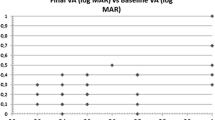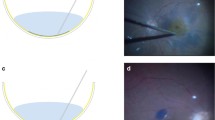Abstract
Background
During macular hole surgery, indocyanine green (ICG) has access to the subretinal space and can lead to toxic and phototoxic damage of the retinal pigment epithelium (RPE). To reduce its toxicity and to avoid contact between ICG and the RPE, we have developed a modified technique by using autologous whole blood.
Methods
Thirty-one eyes underwent vitrectomy for idiopathic macular hole repair. Autologous whole blood (0.1 ml) was injected into the buffered saline solution (BSS)-filled vitreous cavity over the posterior pole and aspirated with a flute cannula. A small clot remained covering the macular hole. The internal limiting membrane (ILM) was stained by using 0.05% ICG solution. The ICG was dissolved in 5% glucose to obtain an iso-osmotic solution. This ICG was injected into the BSS-filled vitreous cavity over the posterior pole and removed after 10 s. The ILM was peeled and a long-acting gas tamponade applied. Pre- and postoperative best-corrected visual acuity and optical coherence tomography (OCT) findings are reported.
Results
Macular hole closure was achieved in 30 of 31 eyes (97%). The mean preoperative logMAR acuity was 0.99 (range: 0.4 to 2.0). Mean postoperative logMAR acuity was 0.496 (range: 0.0 to 1.0). The average improvement in vision was 0.66 logMAR units (range: 1.5 to 0.0). No postoperative RPE alterations were observed biomicroscopically or on OCT.
Conclusion
This surgical technique leads to favorable anatomic and functional results. ICG toxicity is reduced by modifying osmolarity, concentration and contact time and by injecting ICG under BSS. Autologous whole blood acts as a mechanical barrier and prevents ICG from entering in the subretinal space.





Similar content being viewed by others
References
Brooks HL (2000) Macular hole surgery with and without internal limiting membrane peeling. Ophthalmology 107:1939–1948
Burk SE, Da Mata AP, Snyder ME, Rosa RH, Foster RE (2000) Indocyanine green-assisted peeling of the retinal internal limiting membrane. Ophthalmology 107:2010–2014
Czajka MP, McCuen BW 2nd, Cummings TJ, Nguyen H, Stinnett S, Wong F (2004) Effects of indocyanine green on the retina and retinal pigment epithelium in a porcine model of retinal hole. Retina 24:275–282
Da Mata AP, Burk SE, Riemann CD, Rosa RH, Snyder ME, Petersen MR, Foster RE (2001) Indocyanine green-assisted peeling of the retinal internal limiting membrane during vitrectomy surgery for macular hole repair. Ophthalmology 108:1187–1192
Engelbrecht NE, Freeman J, Sternberg P, Aaberg TM, Aaberg TM, Martin DF, Sippy BD (2002) Retinal pigment epithelial changes after macular hole surgery with indocyanine green-assisted internal limiting membrane peeling. Am J Ophthalmol 133:89–94
Ezra E, Gregor ZJ, Morfields Macular Hole Study Group Report No. 1 (2004) Surgery for idiopathic full-thickness macular hole: two-year results of a randomized clinical trial comparing natural history, vitrectomy, and vitrectomy plus autologous serum: Morfields Macular Hole Study Group Report No. 1. Arch Ophthalmol 122:224–236
Facino M, Mochi B, Lai S, Terrile R (2004) A simple way to prevent indocyanine green from entering the subretinal space during vitrectomy for retinal detachment due to myopic macular hole. Eur J Ophthalmol 14:269–271
Gale JS, Proulx AA, Gonder JR, Mao AJ, Hutnik CM (2004) Comparison of the in vitro toxicity of indocyanine green to that of trypan blue in human retinal pigment epithelium cell cultures. Am J Ophthalmol 138:64–69
Gandorfer A, Haritoglou C, Gandorfer A, Kampik A (2003) Retinal damage from indocyanine green in experimental macular surgery. Invest Ophthalmol Vis Sci 44:316–323
Haritoglou C, Gandorfer A, Gass CA, Schaumberger M, Ulbig MW, Kampik A (2002) Indocyanine green-assisted peeling of the internal limiting membrane in macular hole surgery affects visual outcome: a clinicopathologic correlation. Am J Ophthalmol 134:836–841
Haritoglou C, Gandorfer A, Schaumberger M, Tadayoni R, Gandorfer A, Kampik A (2003) Light-absorbing properties and osmolarity of indocyanine-green depending on concentration and solvent medium. Invest Ophthalmol Vis Sci 44:2722–2729
Haritoglou C, Gandorfer A, Gass CA, Schaumberger M, Ulbig MW, Kampik A (2003) The effect of indocyanine-green on functional outcome of macular pucker surgery. Am J Ophthalmol 135:328–337
Haritoglou C, Gandorfer A, Gass CA, Kampik A (2004) Histology of the vitreoretinal interface after staining of the internal limiting membrane using glucose 5% diluted indocyanine and infracyanine green. Am J Ophthalmol 137:345–348
Jackson TL, Hillenkamp J, Knight BC, Zhang JJ, Thomas D, Stanford MR, Marshall J (2004) Safety testing of indocyanine green and trypan blue using retinal pigment epithelium and glial cell cultures. Invest Ophthalmol Vis Sci 45:2778–2785
Kandonoso K, Takeuchi S, Yabuki K, Yamakawa T, Mekada A, Uchio E (2003) Absorption of short wavelengths of endoillumination in indocyanine green solution: implications for internal limiting membrane removal. Graefe’s Arch Clin Exp Ophthalmol 241:284–286
Kusaka S, Sakagami K, Kutsuna M, Ohashi Y (1997) Treatment of full-thickness macular holes with autologous serum. Jpn J Ophthalmol 41:332–338
Kusaka S, Oshita T, Ohji M, Tano Y (2003) Reduction of the toxic effect of indocyanine green on the retinal pigment epithelium during macular hole surgery. Retina 23:733–734
Kwok AK, Lai TY, Yew DT, Li WW (2003) Internal limiting membrane staining with various concentrations of indocyanine green dye under air in macular hole surgeries. Am J Ophthalmol 136:223–230
Lee JE, Yoon TJ, Oum BS, Lee JS, Choi HY (2003) Toxicity of indocyanine green injected into the subretinal space: subretinal toxicity of indocyanine green. Retina 23:675–681
Paques M, Chastang C, Mathis A, Sahel J, Massin P, Dosquet C, Korobelnik JF, Le Gargasson JF, Gaudric A (1999) Effect of autologous platelet concentrate in surgery for idiopathic macular hole: results of a multicenter, double-masked, randomized trial. Platelets in Macular Hole Surgery Group. Ophthalmology 106:932–938
Posselt D, Rahman R, Smith M, Simcock PR (2004) Visual outcomes following ICG assisted ILM peel for macular hole. Eye Jul 2 (Epub)
Sippy BD, Engelbrecht NE, Hubbard GB, Moriarty SE, Jiang S, Aaberg TM Jr, Aaberg TM Sr, Grossniklaus HE, Sternberg P Jr (2001) Indocyanine green effect on cultured human retinal pigment epithelial cells: implication for macular hole surgery. Am J Ophthalmol 132:433–435
Stalmans P, Van Aken EH, Veckeneer M, Feron EJ, Stalmans I (2002) Toxic effect of indocyanine green on retinal pigment epithelium related to osmotic effects of the solvent. Am J Ophthalmol 134:282–285
Van den Biesen PR, Berenschot T, Verdaasdonk RM, van Weelden H, van Norren D (2000) Endoillumination during vitrectomy and phototoxicity thresholds. Br J Ophthalmol 84:1372–1375
Wu WC, Hu DN, Roberts JE (2004) Phototoxicity of indocyanine green on human retinal pigment epithelium in vitro and its reduction by lutein. Photochem Photobiol Sep 1 (Epub)
Author information
Authors and Affiliations
Corresponding author
Additional information
This article is original and has not been published previously.
The authors have no financial interest related to this publication and transfer all copyright to the publisher upon acceptance.
Rights and permissions
About this article
Cite this article
Rizzo, S., Belting, C., Genovesi-Ebert, F. et al. Modified technique for safer indocyanine-green-assisted peeling of the internal limiting membrane during vitrectomy for macular hole repair. Graefe's Arch Clin Exp Ophthalmol 244, 1615–1619 (2006). https://doi.org/10.1007/s00417-006-0316-4
Received:
Revised:
Accepted:
Published:
Issue Date:
DOI: https://doi.org/10.1007/s00417-006-0316-4




